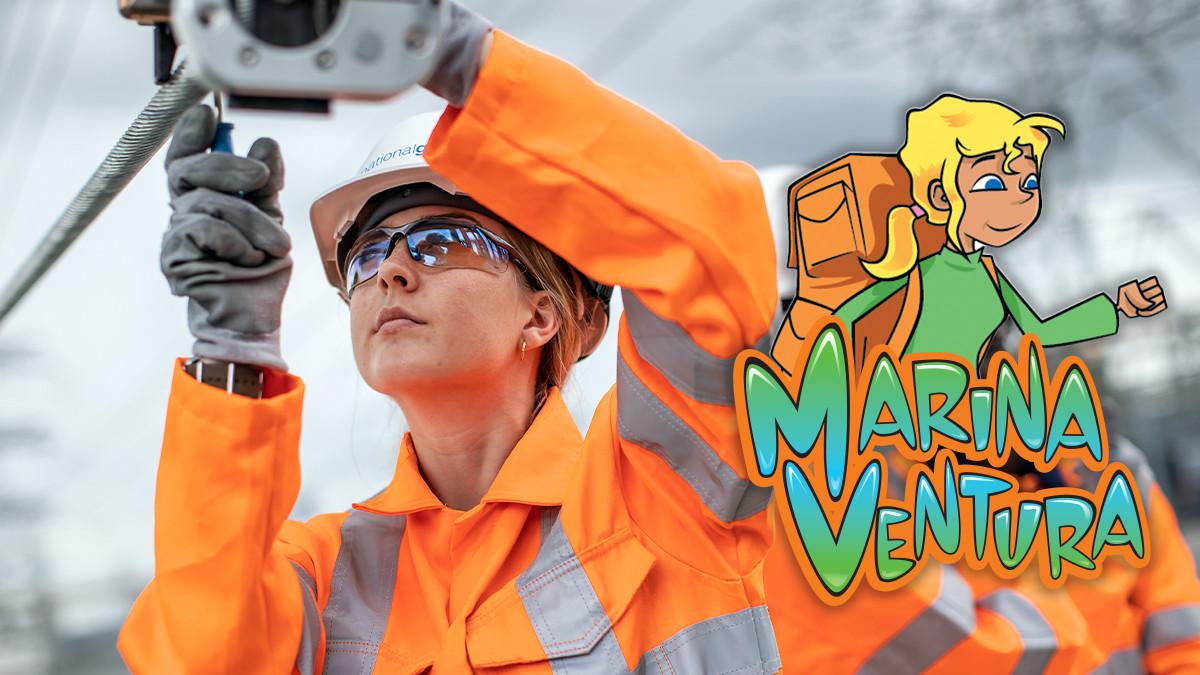
Hi guys! Marina Ventura here.
Map App and I are on a mission to explore the WHAT, HOW and WHY about the pylons that help carry electricity from where it’s produced to where’s its needed.
We want your help to come up with some cool designs for an electricity pylon of the future.
There’s lots to think about – it’s design, what it’s made of and how it’s built. So join us as we find out what makes a perfect pylon!
The British weather can be very varied, from beautiful warm sunny days to powerful storms. To withstand the weather, whatever it is, pylons need to be strong – very strong!
So let’s dive into the nuts and bolts and find out about the materials that are used to make pylons and how they’re put together.
The first ever pylons
The very first pylons were made of wood, just like telephone poles.
In fact, early electrical engineers took some tips from telephone and telegraph networks not just copying their use of wooden poles, but also the types of fittings to connect the networks.
As we needed to zap electricity around at higher powers, further and faster – wood just couldn’t cut it.
Steel
Enter steel, the superhero material that took over because it’s super strong!
Embed from Getty ImagesHere’s a twist – whilst steel is light and strong, which is great it’s also a great conductor of electricity.
That’s not what you want in a pylon that’s supposed to be holding up high-voltage cables without turning into a giant lightning rod!
Insulators
To get around this problem, engineers use things called ‘insulators’ that are made of non-conducting materials like porcelain and glass to provide a safe buffer between the cables and the structures that carry them.
Insulators are designed as discs that stack on top of each other – the more discs, the higher the voltage that can be carried!
Next time you see a pylon, count how many discs are in each stack – it can vary from 3 or 4 to over 20!
Embed from Getty ImagesAnother thing we have to think about is how to build a pylon and safely connect the lines carrying thousands of volts. Sounds a bit more risky than building a pylon out of Lego!
When building new pylons, the first thing to do is clear out vegetation along the route and then mark out where each pylon will be. Normally they’re around 350 metres apart.
That’s like three and a half football pitches!
Foundations
Foundations then need to be dug, with massive concrete pillars drilled into the ground, topped off with reinforced concrete to keep the pylons standing tall.
Embed from Getty ImagesIt’s important that pylons are extremely steady because if one was to fall over, those high voltage cables could hurt people and wildlife, as well as damage buildings.
So foundations are in – let’s get building!
Assembling
Building a pylon itself is like assembling a giant 3D puzzle.
Embed from Getty ImagesAll the various parts of a pylon are made off-site and brought to site on large lorries. Those parts are partially assembled on the ground, using giant nuts and bolts.
The number of sections varies according to the size and type of pylon. Then with the help of cranes, they’re hoisted into place. It’s a bit like watching a construction ballet.
Stringing
Once each pylon is constructed, next up is connecting the wires.
Embed from Getty ImagesThis is called ‘stringing’. The cables arrive on giant drums, 2.5m high and weighing up to 7.5 tonnes. Using steel braided ropes, engineers pull them from one pylon to the next using hefty machinery. It can take around two weeks to string each section.
Extra strong ‘terminal’ towers are located at each end of the route, whilst along the route, tension towers are used if the cables need to be realigned to point in another direction.

What about if the new cables have to cross a road? You don’t want to stop the traffic.
Whenever cables cross roads or rivers, scaffolding and safety nets are erected to keep everyone safe. Traffic management systems might also be used.
So that’s the lowdown on how pylons are built. Making sure electricity gets to light up our homes, charge our devices and more, all without us having to think twice about it.
It’s time to design
We want YOU to help come up with some cool designs for pylons of the future!
Why not get scribbling and start your design for a pylon of the future.
Have a think about some of the important things to consider – what materials will it use, how they’ll be built strong and long-lasting.
We can’t wait to see your ideas! Send them to us here.
Watch Bex design a pylon below…
Listen to Marina Ventura Energy Explorer below!
Marina Ventura Energy Explorer is made with support from Grid for Good by the National Grid.





